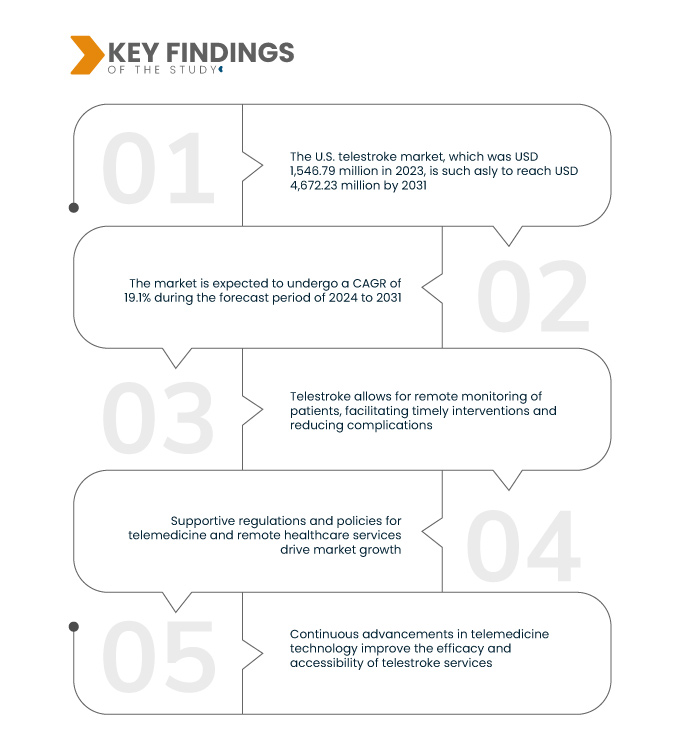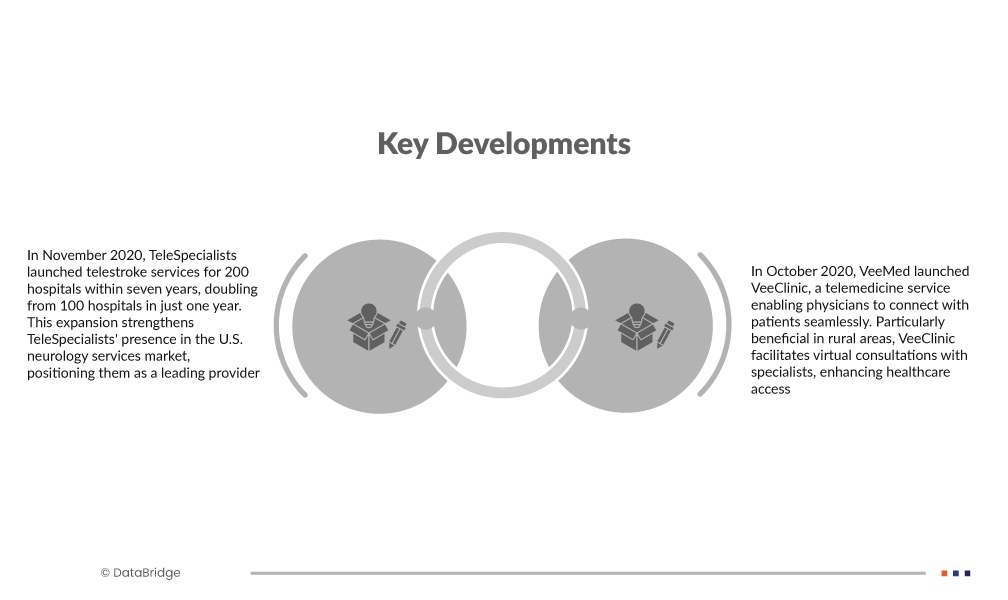In the telestroke market, distribution channels include direct tenders, third-party distribution, and retail sales. Direct tenders involve contracts between telestroke solution providers and healthcare facilities. Third-party distribution utilizes intermediaries to distribute telestroke technology to hospitals and clinics. Retail sales involve direct consumer access to telestroke solutions through online platforms or specialized medical equipment retailers. These distribution channels enable wider access to telestroke technology, facilitating remote stroke care delivery in various healthcare settings.
Access Full Report @ https://www.databridgemarketresearch.com/reports/us-telestroke-market
Data Bridge Market Research analyses that the U.S. Telestroke Market, which was USD 1,546.79 million in 2023, is expected to reach USD 4,672.23 million by 2031, and is expected to undergo a CAGR of 19.1% during the forecast period of 2024 to 2031. Partnerships and collaborations between telemedicine providers, hospitals, and technology firms drive telestroke market growth by extending the reach and adoption of telestroke services through combined expertise and resources.
Aging population is expected to drive the market's growth rate
The aging population, especially in developed nations, propels the demand for stroke care solutions in the telestroke market. As older individuals are at higher risk of stroke, there is a greater need for accessible and efficient care options. Telestroke services cater to this demand by providing remote access to specialized stroke care, allowing timely interventions and improved outcomes. Thus, the aging demographic is a significant driver for the growth of the telestroke market.
Report Scope and Market Segmentation
|
Report Metric
|
Details
|
|
Forecast Period
|
2024-2031
|
|
Base Year
|
2023
|
|
Historic Years
|
2022 (Customizable to 2016-2021)
|
|
Quantitative Units
|
Revenue in USD Million, Volumes in Units, Pricing in USD
|
|
Segments Covered
|
Component (Software, Services, and Hardware), Facilities Service (On-site and Remote), Care Settings (Mobile Stroke Units and Intensive Care Units (ICUs), Emergency Departments (EDs), Medical Surgical Units, Others), Deployment Type (On-Premises and Cloud Based), Stroke Type (Ischemic, Haemorrhagic and Transient Ischemic Attack (TIA)), Application (Pre-Hospital and Hospital Care and Additional Applications), End User (Providers and Patients), Distribution Channel (Direct Tenders, Third Party Distribution, and Retail Sales)
|
|
Market Players Covered
|
Abbott (U.S.), GE Healthcare (a subsidiary of General Electric) (U.S.), VeeMed (U.S.), swyMe (U.S.), TeleSpecialists (U.S.), American Well (U.S.), InTouch Technologies, Inc. (a subsidiary of Teladoc Health, Inc.) (U.S.), iSchemaView, Inc. (U.S.), The General Hospital Corporation (U.S.), Brigham and Women's Hospital (U.S.) , Providence Health & Services (U.S.), Medical University of South Carolina (U.S.), Lakewood Health System (U.S.), Nebraska Medicine (U.S.), CentraCare (U.S.), Mayo Foundation for Medical Education and Research (MFMER) (U.S.) , Rush Medical University Center (U.S.), Penn Medicine (U.S.), UCLA Health (U.S.), Medtronic (Ireland)
|
|
Data Points Covered in the Report
|
In addition to the insights on market scenarios such as market value, growth rate, segmentation, geographical coverage, and major players, the market reports curated by the Data Bridge Market Research also include depth expert analysis, patient epidemiology, pipeline analysis, pricing analysis, and regulatory framework.
|
Segment Analysis:
The U.S. telestroke market is segmented into eight notable segments which are based on component, facilities service, care settings, deployment type, stroke type, application, end user and distribution channel.
- On the basis of component, the U.S. telestroke market is segmented into software, services, and hardware
- On the basis of facilities service, the U.S. telestroke market is segmented into on-site and remote
- On the basis of care settings, the U.S. telestroke market is segmented into mobile stroke units, intensive care units (ICUs), emergency departments (EDs), medical surgical units, and others
- On the basis of deployment type, the U.S. telestroke market is segmented into on-premises and cloud based
- On the basis of stroke type, the U.S. telestroke market is segmented into ischemic, haemorrhagic and transient ischemic attack (TIA)
- On the basis of application, the U.S. telestroke market is segmented into pre-hospital and hospital care, and additional applications
- On the basis of end user, the U.S. telestroke market is segmented into providers and patients
- On the basis of distribution channel, the U.S. telestroke market is segmented into direct tenders, third party distribution and retail sales
Major Players
Data Bridge Market Research recognizes the following companies as the U.S. telestroke market players in U.S. telestroke market are Abbott (U.S.), GE Healthcare (a subsidiary of General Electric) (U.S.), VeeMed (U.S.), swyMe (U.S.), TeleSpecialists (U.S.), American Well (U.S.), InTouch Technologies, Inc. (a subsidiary of Teladoc Health, Inc.) (U.S.), iSchemaView, Inc. (U.S.).
Market Developments
- Product Launch: In November 2020, TeleSpecialists launched telestroke services for 200 hospitals within seven years, doubling from 100 hospitals in just one year. This expansion strengthens TeleSpecialists' presence in the U.S. neurology services market, positioning them as a leading provider. The increased footprint signifies growing adoption of telestroke services, reflecting the importance of remote stroke care solutions in enhancing healthcare accessibility and outcomes
- Product Launch: In October 2020, VeeMed launched VeeClinic, a telemedicine service enabling physicians to connect with patients seamlessly. Particularly beneficial in rural areas, VeeClinic facilitates virtual consultations with specialists, enhancing healthcare access. This expansion into underserved regions strengthens VeeMed's market presence, broadens its customer base, and boosts revenue potential. VeeClinic reflects the growing importance of telemedicine in improving healthcare accessibility and patient care
For more detailed information about the U.S. Telestroke Market report, click here – https://www.databridgemarketresearch.com/reports/us-telestroke-market












